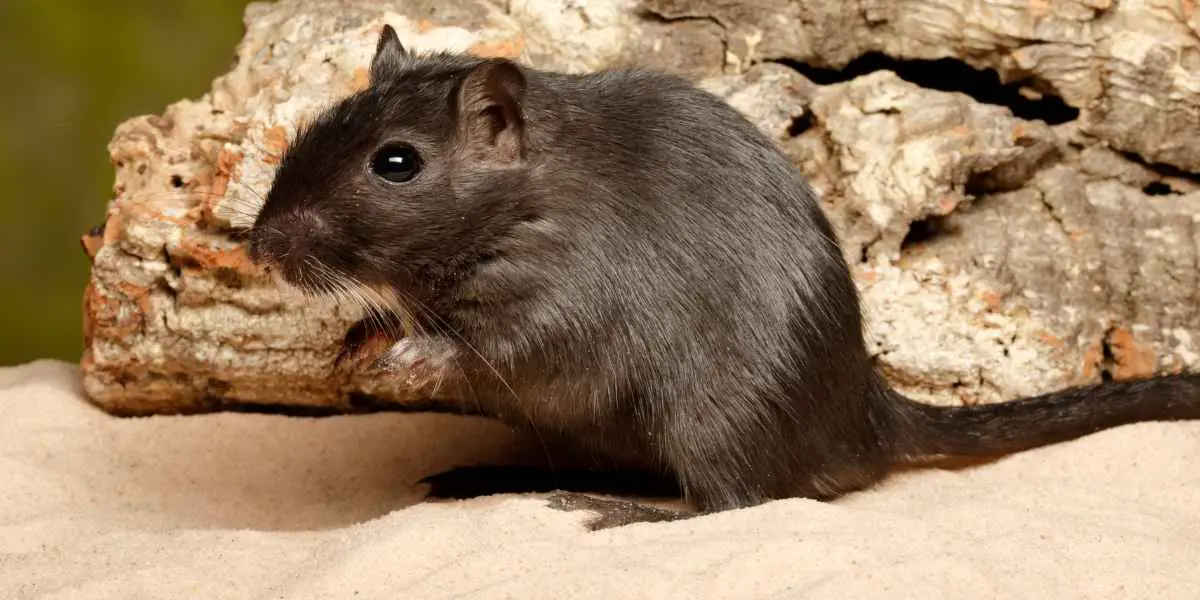Dealing with mites on gerbils can be a stressful experience, but with the right approach, you can eliminate these pesky pests and restore your pet’s comfort and health. To get rid of mites on gerbils, spray their cage, bedding, and toys with a pyrethrin mite spray, clean the cage with bleach, and apply the mite spray on the gerbil, avoiding the head. Repeat these steps until the tissue test shows no signs of mites.
Table of Contents
Key Takeaways:
- Check for the presence of mites by wrapping the gerbil in tissue and looking for red spots or moving dust.
- Remove the gerbils from their cage and spray the cage, bedding, and toys with a pyrethrin mite spray.
- Clean the cage with bleach and water, and add new bedding that has been sprayed with the mite spray.
- Spray the gerbil with the mite spray, avoiding the head, and work it into the fur on the head.
- Repeat the tissue test daily to check for mites and repeat the steps until there are no signs of mites.

How to Get Rid of Mites on Gerbils: Recognizing the Signs and Taking Action
First and foremost, identifying the signs of gerbil mites is paramount before taking any remedial measures. Mites, being tiny parasites, not only feed on your gerbil but can also trigger significant discomfort and even potential health complications.
Prominent indicators of mites on gerbils include:
- Red patches or spots on your gerbil’s skin, which they may scratch or bite frequently.
- Presence of tiny red bugs or what looks like moving dust on their fur, particularly around the neck and tail regions. This is a visible manifestation of the mites themselves.
- Behavioral alterations in your gerbil, such as increased restlessness, agitation, or excessive grooming—often a direct consequence of skin irritation.
Key Signs of Mite Infestation:
- Red patches or spots on the skin.
- Moving dust or granules on the fur.
- Behavioral changes like restlessness or excessive grooming.
Should you spot any of these symptoms of mites or suspect that your gerbil has mites, swift action is essential. By addressing the infestation early, you can prevent further discomfort and stave off complications. It’s crucial to ensure the gerbil’s enclosure is free of mites, as these parasites can live and breed there. Cleaning with a bleach solution, inspecting for any cracks where mites may hide, and thoroughly washing with soapy water can help. Moreover, consulting a pet store or a veterinarian can provide guidance on sprays, dusts, and other treatments to eradicate these arachnids. Remember, while gerbils are susceptible to mite infestations, with the right approach, you can ensure their well-being and comfort.
Removing Gerbils from the Cage and Treating the Environment
To effectively get rid of mites on gerbils, you need to start by removing your pets from their cage and treating the environment. Mites can hide in bedding, toys, and other surfaces, so it’s important to thoroughly clean and disinfect these areas to prevent re-infestation.
Step 1: Begin by gently wrapping your gerbils in tissue to protect them during the process. This will also help you detect any signs of mites, such as red spots or moving dust on the tissue.
Step 2: Once your gerbils are safely wrapped, it’s time to treat the environment. Use a pyrethrin mite spray specifically designed for small animals. Remove all bedding, toys, and accessories from the cage, and spray them evenly with the mite spray, ensuring complete coverage.
| Step | Action |
| 3 | Clean the cage |
| 4 | Add new bedding |
| 5 | Spray the gerbil |
| 6 | Repeat the tissue test |
| 7 | Handle gerbils with care |
| 8 | Consult a veterinarian |
| 9 | Avoid dust baths |
While cleaning the cage, use a mixture of bleach and water to thoroughly disinfect all surfaces, including the walls, shelves, and toys. Rinse everything well to remove any residue. After cleaning, add fresh bedding that has also been treated with the mite spray to ensure any remaining mites are exterminated.
When it comes to treating your gerbils, it’s essential to be cautious. Spray the mite spray onto a cloth or your gloved hand, and carefully apply it to your gerbil’s fur, avoiding the head. Be sure to work the spray into the fur on the head, as mites often hide in this area.
Repeat the tissue test daily to check for mites. If any signs of mites persist, continue the cleaning and treatment process until there are no longer any signs of infestation. Throughout the treatment, remember to handle your gerbils with care, ensuring their safety and well-being.
Consulting a Veterinarian and Avoiding Dust Baths
If you’re unsure about the mite treatment process or if you have any concerns, it is always recommended to consult a veterinarian. They can provide professional advice on mite control for gerbils and offer guidance specific to your pets’ needs.
Avoid using dust baths during the mite treatment process, as they can irritate your gerbils’ skin. Instead, focus on the steps mentioned earlier to effectively eliminate mites from your gerbils’ environment and keep them healthy and comfortable.
Cleaning the Cage and Replacing Bedding
Once you have removed your gerbils from the cage, it’s essential to clean the cage thoroughly to eliminate any remaining mites. Start by emptying the cage and removing all bedding, toys, and accessories. Use a mixture of bleach and water to clean the cage, ensuring that you scrub all surfaces thoroughly. This will help kill any mites that may be hiding in the cage.
After cleaning the cage, it’s important to replace the bedding with fresh material that has been treated with mite spray. Make sure to choose bedding that is safe for gerbils and has been specifically designed to prevent mite infestations. Spread a generous amount of the treated bedding throughout the cage, creating a comfortable and mite-free living environment for your gerbils.
Table: Recommended Cleaning Products for Gerbil Cages
| Product | Description | Price |
| Bleach | A powerful disinfectant that kills mites and other harmful germs | $4.99 per gallon |
| Gerbil-safe bedding | Specifically formulated to repel mites and keep gerbils comfortable | $9.99 per bag |
| Mite spray | A natural and effective solution for eliminating mites from the cage | $12.99 per bottle |
Remember to clean and sanitize any toys or accessories before placing them back in the cage. This will help prevent reinfestation and ensure the gerbils have a clean and safe environment to live in. Regularly monitor the cage and bedding for any signs of mites and repeat the cleaning process if needed. By following these steps, you can effectively exterminate mites from your gerbil’s cage and provide them with a healthy living space.
Applying Mite Spray to the Cage and Bedding
After cleaning the cage and replacing the bedding, it’s time to apply a mite spray to ensure all mites are eliminated. This step is crucial in preventing reinfestation and protecting the health of your gerbils. Using a natural mite spray is recommended, as it is safe for your pets and effective in eliminating mites.
Table: Steps for Applying Mite Spray
| Step | Description |
| 1 | Ensure the cage is well-ventilated and gerbils are temporarily housed in a safe and comfortable environment. |
| 2 | Shake the mite spray bottle well to mix the ingredients. |
| 3 | Spray a generous amount of mite spray on all surfaces of the cage, including the bars, corners, and hiding spots. |
| 4 | Spray the bedding thoroughly, ensuring all areas are covered. |
| 5 | Allow the cage and bedding to dry completely before reintroducing your gerbils. |
Remember to read the instructions on the mite spray bottle for specific usage guidelines. It’s important to follow the manufacturer’s recommendations to achieve the best results.
Why Use Natural Remedies?
Using natural remedies, such as mite sprays made from plant extracts, can be a safer and more eco-friendly option for treating mite infestations in gerbils. These sprays are formulated to target and eliminate mites without harming your pets. They also help to minimize potential allergic reactions or irritations that may occur with chemical-based solutions.
By following the steps above and using a natural mite spray, you can effectively eliminate mites from the cage and bedding, creating a healthier environment for your gerbils to thrive in.
Treating the Gerbils with Mite Spray
Treating your gerbils with mite spray is a crucial step in getting rid of mites and preventing further infestations. Here’s a step-by-step guide to help you through the process:
- Begin by choosing a mite spray specifically formulated for gerbils. Look for products that contain pyrethrin, a natural insecticide.
- Hold the spray bottle about 6-8 inches away from the gerbil’s fur and lightly mist the entire body, avoiding the head. Be careful not to spray directly into the gerbil’s eyes.
- Gently massage the spray into the fur, making sure to cover all areas. Pay extra attention to the base of the tail, the belly, and behind the ears as these are common mite hotspots.
- Allow the spray to dry naturally on the gerbil’s fur. Avoid using a hairdryer or any other heat source as it can cause discomfort to your furry friend.
- Repeat the mite spray treatment every 7-10 days for several weeks to ensure that all mites and their eggs are eliminated. This will help break the mite life cycle and prevent reinfestation.
Remember to handle gerbils with care during the treatment process. Avoid sudden movements or loud noises that may stress them out. If your gerbil shows any signs of irritation or discomfort, cease the treatment and consult a veterinarian for advice.
Tip: It’s always a good idea to wear disposable gloves while handling gerbils during mite treatment to prevent the spread of mites to yourself or other animals.
| Benefits of Treating Gerbils with Mite Spray | Precautions |
| Efficiently kills mites on gerbilsHelps prevent further infestationsSafe for use on gerbils when used as directed | Avoid spraying directly into the gerbil’s eyes or mouthDo not use mite sprays intended for other animalsAlways read and follow the instructions on the product label |
Monitoring for Mite Reinfestation
After completing the mite treatment process, it’s essential to monitor your gerbils for any signs of mite reinfestation. Despite your best efforts to eliminate mites, there is a possibility that they may return, especially if there are any residual eggs or mites left in the environment. By staying vigilant and taking preventive measures, you can ensure the health and well-being of your gerbils.
To monitor for mite reinfestation, you can perform daily checks using a simple tissue test. Take a tissue and gently wrap it around your gerbil, paying close attention to areas such as the neck, ears, and body. Watch for any red spots or moving dust on the tissue, as these could indicate the presence of mites. If you notice any signs, it’s important to repeat the mite treatment process to eliminate the infestation.
In addition to the tissue test, you should continue to maintain a clean and sanitized environment for your gerbils. Regularly clean the cage with a mixture of bleach and water, ensuring that all surfaces are thoroughly disinfected. Replace the bedding regularly and spray it with a pyrethrin mite spray to prevent mites from establishing themselves again.
Key Points:
- Monitor your gerbils for any signs of mite reinfestation using the tissue test
- Repeat the mite treatment process if you notice any red spots or moving dust on the tissue
- Maintain a clean and sanitized environment by regularly cleaning the cage with bleach and water
- Replace the bedding and spray it with a pyrethrin mite spray to prevent mite infestations
| Step | Action |
| 1 | Perform daily tissue tests to check for signs of mites |
| 2 | Clean the cage with bleach and water regularly |
| 3 | Replace old bedding with new bedding that has been sprayed with mite spray |
| 4 | Repeat the mite treatment process if necessary |
Remember to handle your gerbils with care and consult a veterinarian for advice on treatment and prevention. Avoid using dust baths during the mite treatment process, as they can irritate your gerbils’ skin. By following these monitoring and preventive measures, you can keep your gerbils happy and free from mite infestations.
Seeking Veterinary Advice
If you’re unsure about how to effectively treat mites on your gerbils or if the infestation persists, it’s crucial to seek veterinary advice. A veterinarian can provide expert guidance tailored to your specific situation, ensuring the best course of action for your gerbils’ health.
When consulting a veterinarian, make sure to provide them with detailed information about your gerbils’ symptoms, living conditions, and any previous treatment attempts. This will help them assess the severity of the mite infestation and determine the most appropriate treatment options.
Remember, a veterinarian is trained to diagnose and treat a wide range of health issues in gerbils, including mite infestations. Their professional expertise and experience can greatly improve the outcome of your gerbils’ treatment.
In addition to providing treatment advice, a veterinarian can also offer valuable insights on preventive measures to avoid future mite infestations. They may recommend regular cage cleaning routines, proper hygiene practices, and various gerbil care tips that can contribute to maintaining a healthy and mite-free environment for your furry companions.
| Benefits of Seeking Veterinary Advice |
| Accurate diagnosis and tailored treatment plans |
| Access to professional expertise and experience |
| Preventive measures to avoid future infestations |
By consulting a veterinarian, you’ll not only ensure the well-being of your gerbils but also gain peace of mind knowing that you’re following the most effective and safe strategies to eliminate mites and prevent their return.
Handling Gerbils with Care
Throughout the mite treatment process, it’s essential to handle your gerbils with care to minimize stress and ensure their well-being. Here are some important tips to keep in mind:
- Always approach your gerbils calmly and with gentle movements. Sudden and rough handling can frighten them and cause unnecessary stress.
- When picking up your gerbil, support their body with both hands, cradling them gently. Avoid grasping or squeezing them too tightly, as this can cause discomfort or injury.
- During the treatment, it’s important to avoid getting the mite spray into your gerbil’s eyes. Shield their eyes with your hand or a cloth while applying the spray, focusing on the fur and avoiding the head area.
- After treating your gerbil, allow them some time to adjust and groom themselves. Avoid disturbing or handling them immediately after the treatment to prevent any potential irritations.
- If your gerbil shows signs of distress, such as squealing or trying to escape, gently place them back into their cage and give them some space. It’s crucial to respect their boundaries and provide a calm environment.
Remember, gerbils are delicate creatures, and proper handling is key to their overall well-being. By following these tips, you can ensure that your gerbils feel safe and comfortable throughout the mite treatment process.
Handle with Care for Happy Gerbils
“Gerbils are sensitive animals that thrive in a calm and quiet environment. Handling them with care during the mite treatment process is crucial for their overall health and well-being.” – Dr. Emily Johnson, Veterinarian
If you have any concerns or questions about handling your gerbils during the mite treatment, it’s always a good idea to consult with a veterinarian who specializes in small animals. They can provide you with personalized advice and guidance based on your specific situation.
Summary
Dealing with mites on gerbils requires careful handling and a gentle approach. Remember to support your gerbil’s body when picking them up, shield their eyes during the mite treatment, and give them time to adjust afterward. Seek professional advice if needed, and ensure a stress-free environment for your furry friends. By following these tips, you can help your gerbils overcome mite infestations while keeping them happy and healthy.
| Care tips for handling gerbils during mite treatment: |
| Approach calmly and with gentle movements |
| Support their body when picking up |
| Avoid getting spray into their eyes |
| Allow them time to adjust and groom themselves |
| Respect their boundaries and provide a calm environment |
Avoiding Dust Baths
While dust baths are a popular method for gerbil hygiene, it’s crucial to avoid using them during the mite treatment process. Dust baths can potentially irritate the gerbils’ skin and exacerbate the mite infestation. Instead, consider alternative methods to maintain your gerbils’ hygiene until the mites are completely eliminated.
One effective alternative is using a damp cloth to gently wipe your gerbils’ fur. This helps remove any dirt or debris without the risk of aggravating the mite problem. Be sure to use lukewarm water and avoid excessive wetting, as gerbils are sensitive to temperature changes.
Another option is spot cleaning. Regularly inspect the gerbil cage for soiled areas and remove any bedding or materials that may have been contaminated by mites. Replace these with fresh, clean bedding that has been treated with mite spray. This helps ensure that your gerbils have a hygienic living environment while the mite treatment is ongoing.
Remember, the key during the mite treatment process is to prioritize the well-being and comfort of your gerbils. By avoiding dust baths and implementing alternative methods of hygiene, you can help alleviate any discomfort caused by mites while effectively managing the infestation.
Table: Alternative Hygiene Methods During Mite Treatment
| Method | Description |
| Using a damp cloth | Gently wipe your gerbils’ fur with a damp cloth to remove dirt and debris without irritating their skin. |
| Spot cleaning | Regularly inspect the cage and remove any soiled bedding or materials, replacing them with fresh, treated bedding. |
Conclusion
By following these steps and taking prompt action, you can successfully get rid of mites on your gerbils and ensure their comfort and health. Start by checking for the presence of mites by wrapping your gerbil in tissue and looking for red spots or moving dust. If mites are detected, remove the gerbils from their cage and spray the cage, bedding, and toys with a pyrethrin mite spray.
Next, thoroughly clean the cage with a bleach and water solution, and add new bedding that has been sprayed with the mite spray. To treat the gerbil itself, spray it with the mite spray, avoiding the head, and gently work it into the fur on the head.
Repeat the tissue test daily to check for mites, and continue the steps until there are no signs of mites. Remember to handle your gerbils with care and avoid getting the spray into their eyes. If you have any concerns or questions, it is always a good idea to consult a veterinarian for advice on treatment and prevention.
During the mite treatment process, it is important to avoid using dust baths, as they can irritate your gerbils’ skin. Instead, focus on maintaining their hygiene through other methods. By following these guidelines, you can ensure the well-being of your gerbils and prevent future mite infestations.
| Key Points: |
| – Wrap the gerbil in tissue to check for mites |
| – Spray the cage, bedding, and toys with mite spray |
| – Clean the cage with bleach and water, and add new bedding |
| – Spray the gerbil, avoiding the head, and work the spray into the fur |
| – Repeat the tissue test daily and consult a veterinarian if needed |
| – Handle gerbils with care and avoid dust baths |




